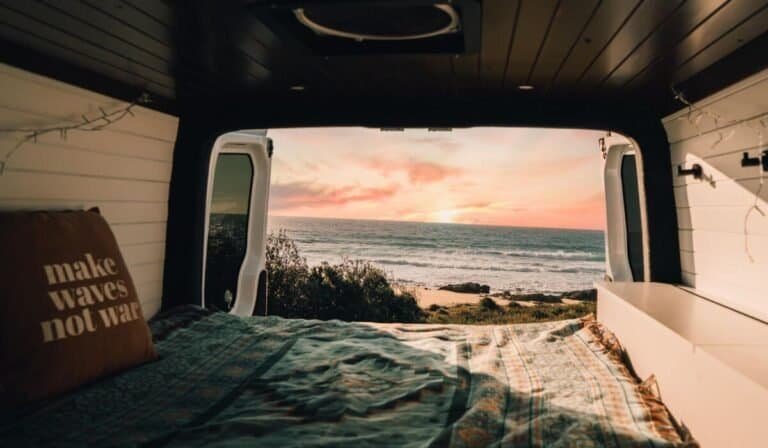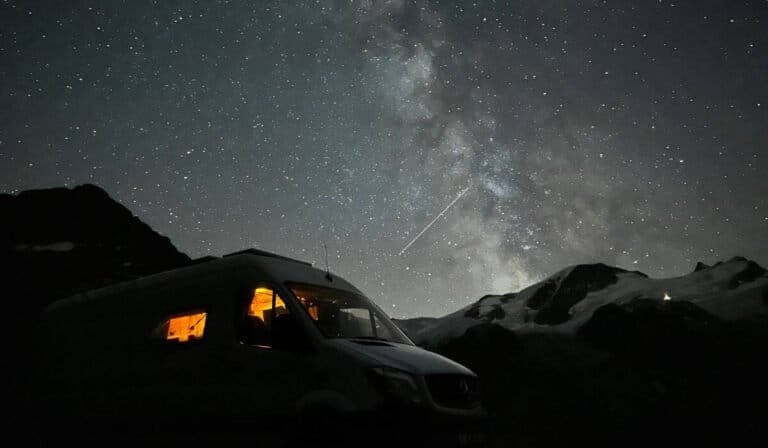Finding the Perfect Toilet for Your Van: A Comprehensive Guide 🚽
Ahhh, ‘Campervan Toilets’… hardly the highlight of vanlife or something you’d want to splash all over Instagram. But, after planning our van build for over 3 years and living on the road for more than 2 in our trusty steed ‘El’, we’ve had plenty of time to dive into all the options for #Vanlife Toilets.
Let’s cut to the chase: there’s no totally non-gross way to handle bathroom business in vanlife. 😞
Sadly, no matter which van toilet you choose, it will never be as convenient or pleasant as a regular, plumbed house toilet. But, for many of us, the countless upsides of vanlife make this small downside worth it. 🤗
With that said, figuring out the right bathroom solution for you, one that meets your needs as best as possible is key. And with this article, we want to make all the options available clear to you.
There are various choices, each suited to different lifestyles, van setups, and budgets. But by understanding the features, benefits, and drawbacks of each, you can make a well-informed choice.
So, camper van toilets…..let’s dive in….ew

Want to know all about showering in van life? Here’s our guide to the Best Van Shower Options
Do You Need a Toilet in Your Campervan? Let’s Weigh the Pros & Cons
When considering if you need a toilet for your van, it’s essential to reflect on your travel habits, personal preferences, the destinations you will be travelling to and how long for.
- Are your journeys primarily extended road trips, or do you prefer weekend getaways closer to home?
- Are you venturing off the beaten path, or do you prefer staying at well-equipped campgrounds?
- Do you value the convenience of having a toilet readily available, or are you more concerned about maximising space for living and storage?
- How much will emptying and cleaning out a campervan toilet bother you?
These are just a few of the questions you should ask yourself as you read through this article, to help you find the best campervan toilet options for your circumstance.
Now, to further help make this decision, let’s dive into the pros and cons of having a camper van toilet.
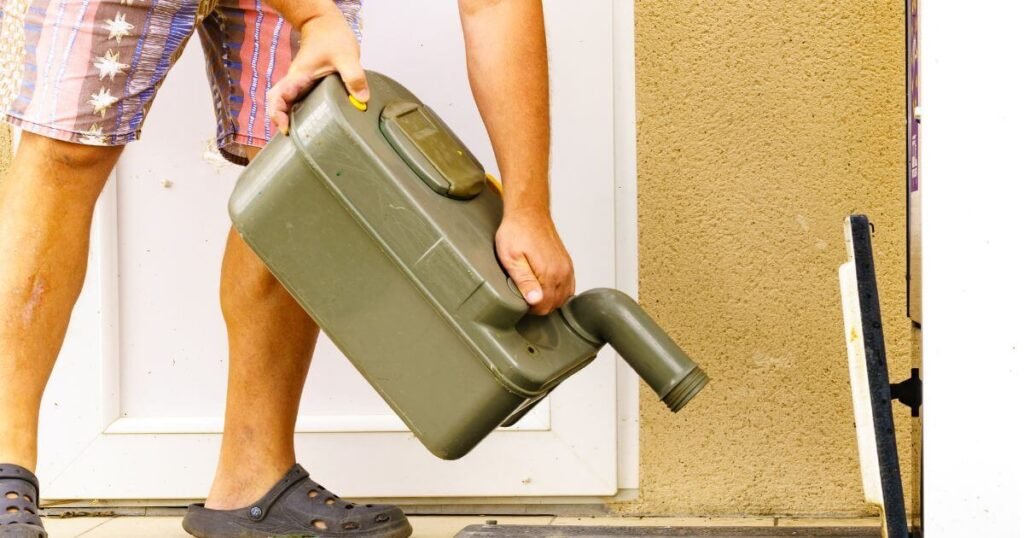
✅Pros of Having a Campervan Toilet:
- 👍 Convenience and Accessibility: A toilet in your campervan ensures you have immediate access, eliminating the need to find public restrooms or rely on campsite facilities, especially in remote areas.
- 🤭 Privacy: Having your own toilet offers greater privacy, which can be particularly beneficial during night-time or in crowded camping spots.
- 🤸 Flexibility: A campervan toilet allows you to camp anywhere without worrying about restroom availability. This can enhance your freedom and spontaneity on the road.
- 🧼️ Hygiene: Using your own facilities can be more hygienic than public restrooms, especially in high-traffic tourist areas.
- 😇 Homely feeling: Having a toilet in your van could help some feel more comfortable and therefore more at home in their house on wheels
❌ Cons of Having a Campervan Toilet:
- 📏 Space Consumption: Toilets can take up valuable space in your van, which could be used for storage or living areas. This is a crucial factor in smaller vans where every inch counts.
- 🧽️ Maintenance and Cleaning: Campervan toilets require regular maintenance and cleaning. Emptying waste and cleaning the unit can be unpleasant and time-consuming.
- 💰 Cost: Installing a toilet in your campervan can be an additional expense. Beyond the initial purchase, there are ongoing costs for maintenance supplies and potential repairs.
- 👃 Odour Concerns: Without proper ventilation and routine cleaning, campervan toilets can be seriously stinky.
- ⚖️ Added Weight: A toilet system, particularly with a water supply, can add significant weight to your van, impacting fuel efficiency, and handling and pushing you closer to your legal road limit.
By weighing these pros and cons, you can start to make a more informed decision about whether a campervan toilet fits your lifestyle and travel needs.
The ‘No Toilet’ Option for Vanlife
Choosing the ‘No Toilet’ option for your campervan can be liberating, offering a minimalist approach that aligns perfectly with the adventurous spirit of vanlife. But as with everything, this setup offers its own unique set of benefits and challenges.
☑️ Benefits of Going Without a Toilet
- 📐 Space and Flexibility: Removing a fixed toilet from your campervan means maximizing available space. This can be a game-changer for small van conversions, allowing it to feel more open, in addition to more room for storage, extra seating, or a comfortable sleeping area.
- 🤑 Cost-Effective: Skipping the installation of a campervan toilet reduces initial costs and eliminates the need for ongoing maintenance. You save on plumbing, cleaning supplies, and potential repairs, making it a budget-friendly option.
- 😇 No maintenance or bad smells: going for this option eliminates the hassle of maintaining your toilet unit – no more worrying about bad smells, the unpleasant task of cleaning your toilet, or finding places to dump your waste.
✖️ Drawbacks of Not Having a Toilet
- 😒 Inconvenience and Planning: Without a toilet of any kind in your van, you must be really strategic about your bathroom stops and where you park. This could be a major inconvenience, especially in remote areas where facilities are sparse. Plus…sometimes you just need to go, NOW!
- 🚻 Limited Privacy: Public restrooms or outdoor facilities can compromise your privacy. For some, this may detract from the comfort and freedom typically associated with van life.
- 🌷 Environmental Impact: Improper waste disposal in natural areas can harm the environment. It’s crucial to follow ethical practices to minimise your footprint.
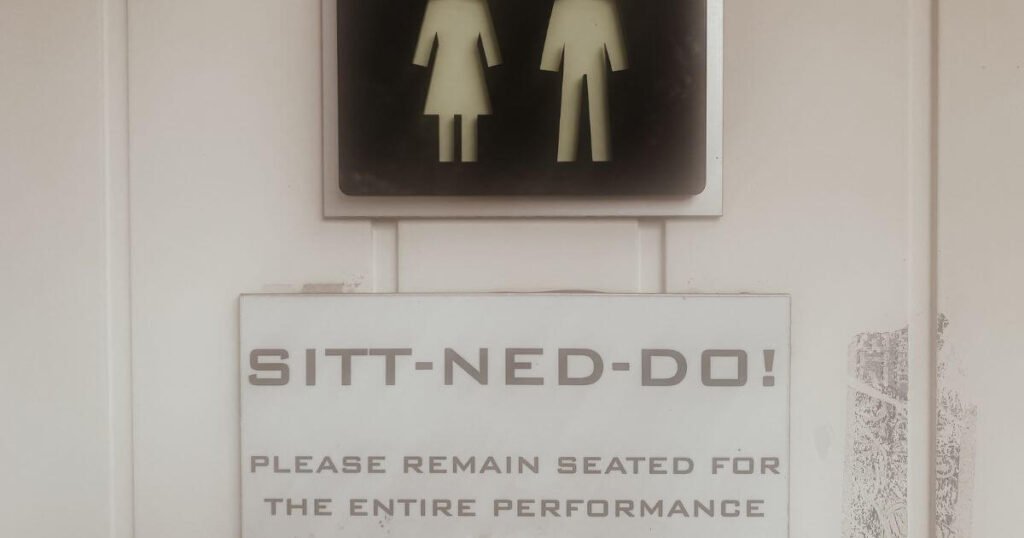
Where Do I Go if I Don’t Have a Campervan Toilet?
Public restrooms are widely available in urban and suburban areas and at roadside laybys and service stations. You’ll find them in shopping centres, fast food stores, supermarkets, public parks, leisure centres and beaches. Campgrounds also often provide clean facilities, and many cafes or restaurants offer restrooms for customers.
These options can be more comfortable and spacious compared to the confines of a campervan toilet. Also, apps like Park4Night, iOverlander or Google Maps can help locate nearby facilities.
😬 For those times when nature calls unexpectedly, being prepared with portable solutions like a foldable toilet, pee bottles and she-wees or a simple bucket system can be invaluable.
The Dos and Don’ts of Going in the Wild
For those times when nature calls in the wild, it’s important to follow some essential dos and don’ts.
Do:
- 🕳 Use a trowel to dig a small hole at least 6 inches deep to bury human waste, ensuring you’re at least 200 feet away from water sources and trails. Make sure you re-fill this hole.
- 🧻️ Pack out used toilet paper in a sealed bag, NEVER leave it behind, or use biodegradable paper to minimise environmental impact.
- Use natural, biodegradable hygiene products whenever possible.
Don’t:
- 🎣 Leave waste exposed or too close to water bodies.
- 🧑⚖️ Assume every wilderness area has the same waste disposal rules; always check local regulations.
- Forget to carry hand sanitiser or eco-friendly soap.
Every traveller and vanlifer should be familiar with the ‘Leave No Trace’ principles, to ensure you are as environmentally friendly as possible. Check out this article from the National Park Service to ensure you are fully versed.
Choosing not to have a dedicated campervan toilet is a personal decision that for some can align with the desire for a simpler, more minimalist lifestyle.
You will want to ensure that you have options in case of emergencies. However, by planning ahead and respecting the environment, it is possible to enjoy the freedom of the road without the burden of a traditional toilet system.

Types of Campervan Toilets | How to go to the Bathroom in a Van.
So you have decided that you want to have a toilet system of some kind… the ‘No Toilet’ option isn’t for you.
When it comes to outfitting your campervan with a toilet, there are various options available, each with its own set of features, advantages, and disadvantages.
In this section, we will dive into the main types of campervan toilets: built-in RV toilets, portable toilets, collapsible camping toilets, semi-fixed cassette toilets and composting toilets.
Understanding the differences between them will help you choose the best option for your needs.
Plumbed-in/ Flushable RV Toilets for Vanlife
Built-in RV toilets are permanent fixtures connected to the van’s plumbing system. They typically feature a flushing mechanism and are connected to a black water tank for waste storage. These toilets are the closest experience to your home bathroom that vanlife can offer.
Pros
- The most comfortable and convenient option, similar to a household toilet.
- Large waste capacity, suitable for long trips.
- The flushing system helps maintain cleanliness and reduce odours.
- Permanently installed, providing stability and ease of use.
Cons
- Requires significant installation effort and space within the van.
- More expensive than other types of toilets.
- Needs regular maintenance of the black water tank and plumbing system.
- You’ll face more restrictions on where to dispose of blackwater waste, needing more time at campsites and designated disposal areas.
- Adds a lot of weight to your build.
- Not suitable for extreme winters as the black water tank will freeze leaving the toilet unusable.
Price Range
Built-in RV toilets can range from £400 to £1,200, depending on the model and features such as macerator systems and porcelain bowls.
Ease of Clean Up
The black water tank must be emptied at designated dump stations. The tank should be cleaned regularly to prevent buildup and odours.
Popular Brands and Examples
- Dometic 320 Series: Known for its full-size ceramic bowl and powerful flush.
- Thetford Aqua-Magic V: A lightweight option with a foot pedal flush.
- SeaLand 510 Plus: Features a low-profile design and efficient water use.
Best Scenarios for Use
Built-in RV toilets are best for full-time van dwellers and those who prioritise comfort and convenience. They are ideal for travellers who spend a lot of time on the road, and in campsites and require a reliable and easy-to-maintain toilet system.
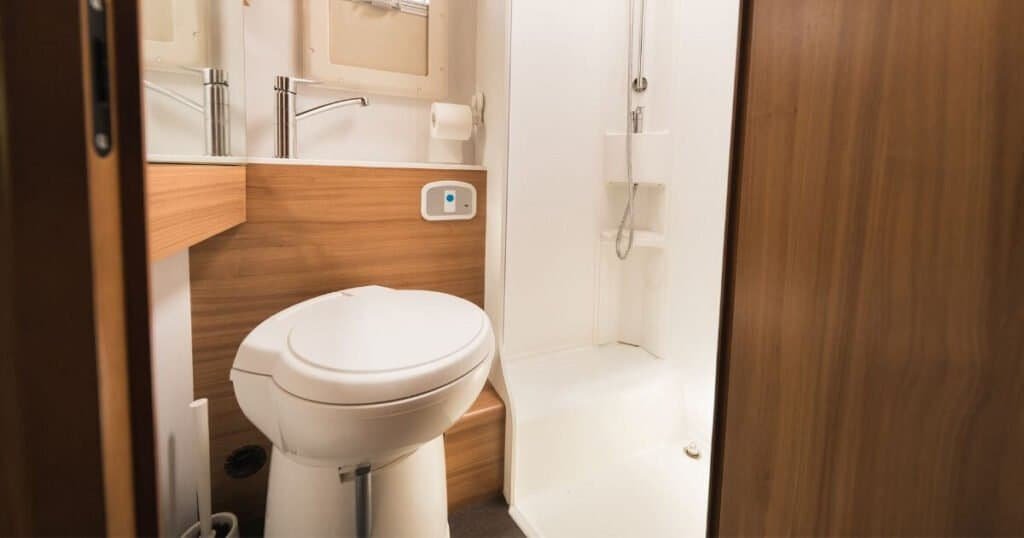
Portable Toilets for your Van
Portable toilets are self-contained units that are easy to transport and do not require permanent installation. They typically consist of two parts: a freshwater tank for flushing and a waste tank to collect waste. These toilets are designed for convenience, manoeuvrability and ease of use.
Pros
- Highly portable and can be used outside the van if needed.
- Easy to set up and use.
- Generally inexpensive compared to other types of van toilets.
- No need for complicated plumbing or permanent installation.
Cons
- Requires regular emptying of the waste tank, which isn’t pleasant.
- May have limited capacity, making them less ideal for longer trips and extended use.
- Can be less comfortable than other types due to their smaller size.
- Potential for spillage during emptying if not handled carefully.
- Can require chemical use to keep from smelling (which doesn’t always work) and isn’t overly environmentally friendly.
Price Range
Portable toilets vary widely in price, from approximately £40 to £150 for more basic porta potty like designs, and can go up to around £1000 for some of the more modern battery-operated brands.
Ease of Clean Up
Depending on your specific toilet, cleaning a portable toilet usually involves detaching the waste tank and emptying it at a designated disposal site. This isn’t always easy and pleasant and you probably want to be wearing gloves to do this.
The tanks are usually treated with chemicals to break down waste and reduce odour. They require frequent cleaning and emptying.
Popular Brands and Examples
- Thetford Porta Potti 565E: Known for its high capacity and ease of use.
- Dometic 970 Series: Features a push-button flush system and compact design.
- Laveo Dry Flush Toilet: Innovative portable electric toilet that is waterless, odourless, chemical-free, low-maintenance, and compact. But comes with a more premium price tag.
- Camco Standard Portable Travel Toilet: Offers a budget-friendly option with a detachable waste tank for easy cleaning.
- The Luggable Loo: Cheapest van life portable toilet option, but is very basic.
Best Scenarios for Use
Portable toilets are ideal for van owners who prefer not to make permanent modifications to their build. They are also good for short trips, occasional use, and situations where you need a flexible and easy-to-move solution.
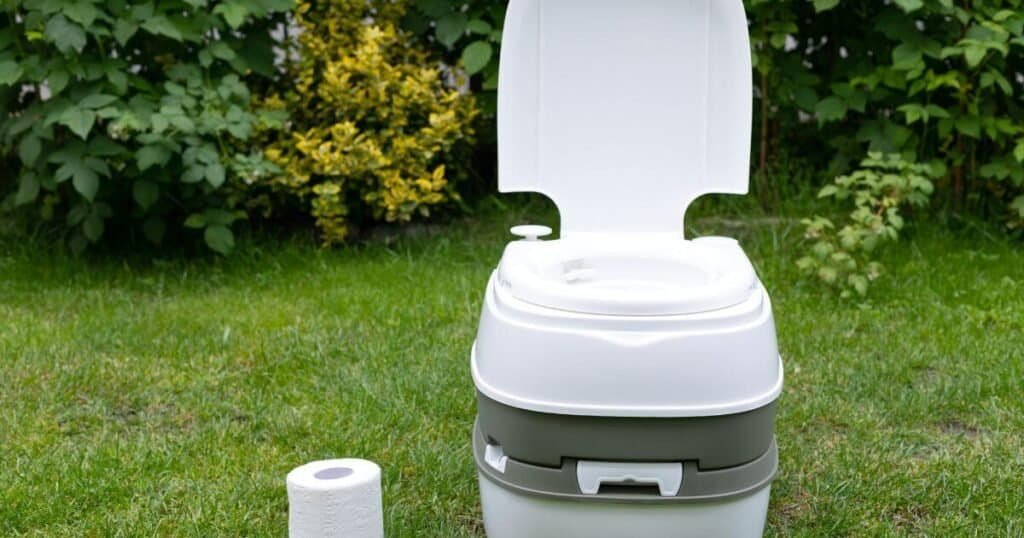
Pop-Up Camping Toilets for Vanlife
Pop-up camping toilets suit van lifers who seek a compact emergency toilet option without sacrificing space. They’re easy to transport and set up, ideal for those who value minimalism and functionality.
Lightweight and designed for fast assembly, they feature a sturdy frame and a disposable bag system for waste. Perfect for campers needing a portable, easy-to-store toilet, these are one-time-use solutions designed for quick disposal, not waste storage.
Pros
- Extremely lightweight, small and portable (can be packed away in a cupboard)
- Easy to set up and fold down.
- Affordable and cost-effective.
- No need for water or plumbing.
- Clean-up is more manageable (just need to discard a bag)
Cons
- Requires disposable bags, which need to be purchased separately.
- Less stable than more permanent options.
- Limited comfort for extended use.
- If you can’t dispose of the bag immediately, it must stay in the van until you find somewhere.
- Requires set up before use.
- You may also need pee bottles with this set-up for emergency/nighttime goings. Pop-up toilets are for #2 only.
Price Range
Depending on which option you go for you will be looking at roughly between £40-100.
Ease of Clean Up
The included waste bags with treatment powder make cleanup easy and sanitary. After use, the bag can be sealed and disposed of in accordance with local regulations, reducing odour and mess.
Popular Brands and Examples
- The Bivvy Loo: A simple yet effective pop-up toilet with a collapsible design for easy storage.
- TripTips Retractable Toilet: A versatile option designed with a retractable, accordion-like structure that allows it to collapse into a compact form.
- The ‘Cleanwaste Go Anywhere’ Collapsible Toilet: More robust and reliable and features a three-legged design for stability.
Best Scenarios for Use
Short camping trips where space and weight matter, or for those who need an emergency toilet for number 2’s that’s compact and saves on space. It also removes the need to clean basins or empty black water tanks and prevents van odours by ensuring waste is disposed of immediately, with none kept on board.
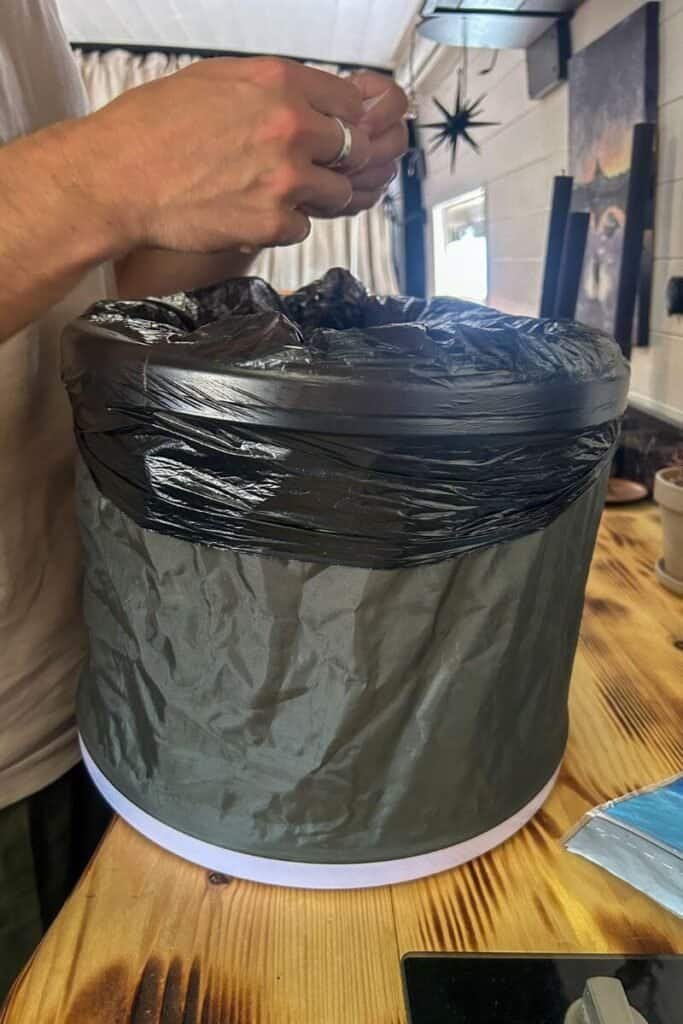
Semi-Fixed Cassette Campervan Toilets
Cassette toilets are often semi-permanent fixtures that combine the convenience of a portable toilet with the stability of a built-in system. They function similarly to a home toilet, except they have a collection tank instead of going into the sewer system.
When using this toilet you will open a trap door each time you use it (regardless of the duty) and then flush it after each use before shutting the trap door. They have a fixed toilet bowl connected to a removable waste cassette that is also portable and can often be accessed from outside the van for easy emptying.
Cheaper cassette toilets can come in completely portable ‘Porta Potti’ formats as covered in the ‘Portable Campervan Toilets’ section.

Pros
- Fixed installation provides more stability and comfort.
- Removable waste cassette allows for easier emptying and cleaning.
- Generally has a larger capacity than portable toilet versions.
- Can be equipped with a flushing system.
Cons
- Requires some level of installation and may need space dedicated to the waste cassette.
- Can be more expensive than other portable options.
- Can be quite smelly.
- Regular maintenance is required to keep the system functioning properly.
- More complex installation process may necessitate professional help.
- They generate black water which must be disposed of at “Campervan Dump Stations”.
- Not overly environmentally friendly with the constant use of chemicals.
Price Range
Cassette toilets range from roughly £150 to £500, with higher-end models offering advanced features like electric flush systems and larger waste tanks.
Ease of Clean Up
The waste cassette can be easily removed and emptied at designated disposal sites. Some models come with wheels and handles for easier transport. Regular cleaning of the toilet bowl and cassette is necessary to maintain hygiene and prevent smells.
Popular Brands and Examples
- Thetford C223-CS: Features a swivel bowl and electric flush.
- Dometic CTS3110 & 4110: Known for its sleek design and efficient use of space.
- Thetford C403L: Offers a large waste tank and an easy-to-use control panel.
Best Scenarios for Use
Cassette toilets are ideal for frequent travellers who need a reliable and comfortable toilet system. They are particularly useful for long trips and remote locations where facilities may not be available.

Composting Campervan Toilets
Composting toilets have taken off in popularity amongst van lifers in recent years. They function like porta potties but with added composting materials. These waterless, chemical-free toilets naturally break down waste into compost, separating liquid and solid waste into two containers.
The solid waste composts over time, requiring an initial load of Coconut Coir or Peat Moss. A fan in the solids bin, venting outside, minimises odour by removing smells and drying the compost.
Using the toilet for peeing is straightforward. For solid waste, simply open a trap door to the solids bin before use and close it afterwards. After use, turn a handle three times to mix the contents. There is no need to add more composting material after each use.
Pros
- More environmentally friendly and sustainable.
- No need for water, making them ideal for off-grid use.
- Can be used for extended periods without needing to be emptied.
- Reduces odours compared with cassette toilets by separating liquids and solids, and models with vent fans take all of the smell out.
Cons
- Larger and more complex than other types, requiring more space and installation effort.
- Requires regular maintenance and monitoring of the composting process.
- More expensive than most portable and cassette toilets.
- Major composting toilet brands need a 12V power supply for the small vent fan.
- More complex installation process may necessitate professional help.
- Although they claim to be smell-free, from our experience, we wouldn’t completely agree.
Price Range
Composting toilets can range from £800 to £1,500, reflecting their complexity and sustainable features.
Ease of Clean Up
Composting toilets require solid waste removal periodically, which can be used as compost if properly processed. The liquid tank needs to be emptied more frequently.
Regularly mixing the compost material and adding bulking agents like sawdust is necessary to ensure proper decomposition.
Popular Brands and Examples
- Nature’s Head Self-Contained Composting Toilet: Highly regarded for its efficiency, ease of use, and the largest capacity composting toilet on the market.
- Separett Villa 9215: Features a urine diversion system and fan for ventilation.
- Combo Closet Cuddy: Known for its sleek design and ease of use
- OGO Composting Toilet: Very compact, light, and modern, with a smaller environmental footprint compared to other composting toilets.
- Trelino Evo Composting Toilet: Easiest Campervan Composting Toilet to Dump
- Airhead Composting Toilet: Largest Solid Capacity
Best Scenarios for Use
Composting toilets are perfect for more eco-conscious travellers and those planning to spend extended periods off-grid. They are suitable for van owners who have the space and are willing to invest time in maintenance.
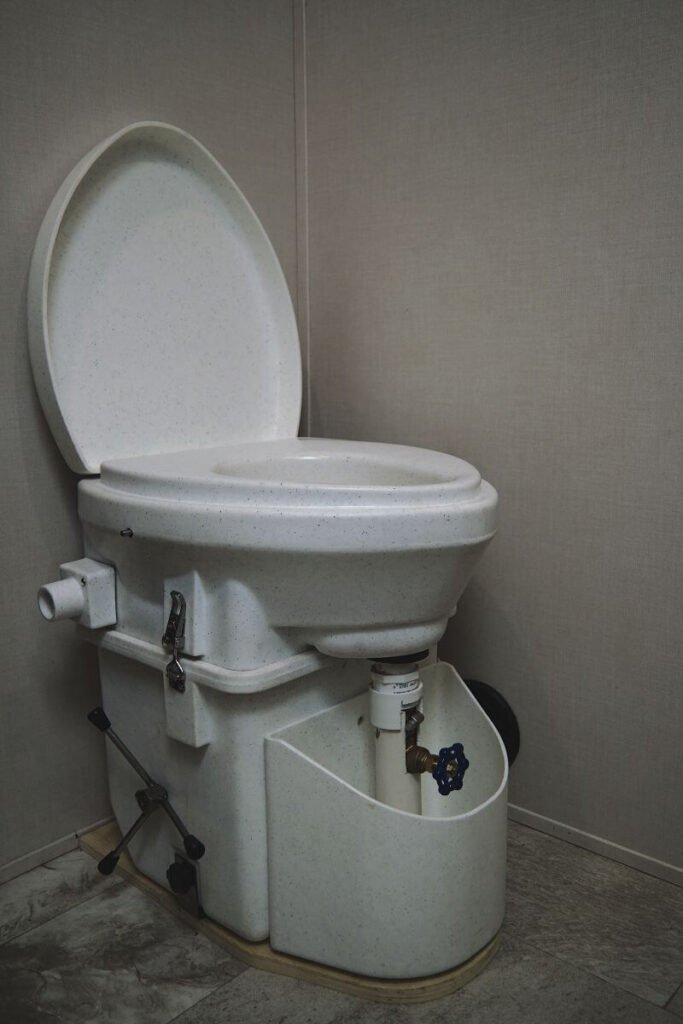
Pee Bottles & She Wees for Vanlife
If you opt for a pop-up or no toilet, you’ll probably still want an option for emergencies or nighttime.
Pee bottles are a popular option for this. And for the ladies, if you go this route you will want to invest in a ‘She-Wee’.
She wees, or pee funnels, are devices that enable women to urinate standing up, providing a convenient way to use a pee bottle or relieve oneself outdoors without fully undressing. These funnels are designed to prevent spills and offer much-needed privacy.
Although they can feel weird at first and be tricky to get used to, they are a real game changer once you get the hang of them.
Tips for Use and Maintenance 👍
Pee Bottles
- Choose the Right Size: Ensure the pee bottle has sufficient capacity for your needs.
- Secure Seal: Opt for bottles with tight-sealing caps to prevent leaks.
- Regular Cleaning: Clean thoroughly with soap and water after each use to maintain hygiene.
She Wees
- Practice First: Practice using the she wee outside or in a shower, to get comfortable with the technique before moving on to the pee bottle.
- Cleaning: Rinse the She Wee with water or wipe it with biodegradable wet wipes after use to keep it clean.
- Storage: Store in a clean, dry place and consider carrying a small pouch for discreet transport.
How to Choose the Right Toilet for Your Van: Things to Consider
When choosing the right toilet for your van, it’s essential to consider a variety of factors that align with your unique lifestyle and travel plans. Here are some key points to help guide your decision-making process:
🚐 Full-Time vs. Part-Time Van Living
If you’re living in your van full-time, plan to spend time at campsites and want maximum convenience, investing in a high-quality, durable toilet might be worthwhile.
Plumbed-in RV toilets, semi-permanent cassettes and many composting options offer long-term convenience but require more maintenance.
However, for part-time van dwellers, portable or pop-up toilets can be more practical due to their simplicity and lower cost. These can also work for more full-timers who are happy to live more minimally and want less cleanup and time spent at dumping stations.
🍁❄️ Seasonal Travel Plans
If you plan to travel during colder months, consider how your toilet will perform in low temperatures. Some chemicals used in portable toilets can freeze, making them less effective. So where you position them in the van will be important.
Composting toilets aren’t generally affected by temperature changes, making them a solid choice for winter travellers.
Any option with an outside black water tank will be rendered useless if that tank freezes in extreme cold.

Interested in trying winter in your van? Check out our Winter Van Life Guide
💲Budget
Your budget will significantly influence your options. Composting toilets provide eco-friendly waste management but come with a higher upfront cost. Certain cassette toilets are more affordable but require ongoing purchases of chemicals.
Or you can go for the completely budget pop-up toilet option. It’s important to weigh initial costs against long-term expenses.
📏 Van Size and Layout
Space is a crucial consideration in campervans. A larger van may accommodate a more permanent setup, while a smaller van might require a compact, portable option.
Consider whether you can allocate enough space for a toilet without sacrificing essential living or storage areas.
🚶♂️Ease of Installation and Portability
For those who frequently move or rearrange their van setup, a portable toilet that is easy to install and remove is ideal. Portable and pop-up toilets are typically light and can be stored away when not in use, while fixed toilets require more effort to install but provide a permanent solution.
⛺️ Lifestyle Preferences (Wild vs. Urban Camping)
Your camping style will influence your toilet choice. You should ask yourself how much time you plan to spend in urban areas or at campsites.
If the answer is “not often” where will you responsibly dump your waste if you have an underslung black tank or chemical toilets? This will differ depending on the country you are in and how geared up they are for van lifers.
Perhaps in this scenario, a more environmentally friendly composting toilet option would be for you, or a budget ‘use it and then bin it’ pop-up toilet with pee bottles would work better.
Or a good ol’fashioned nature 💩
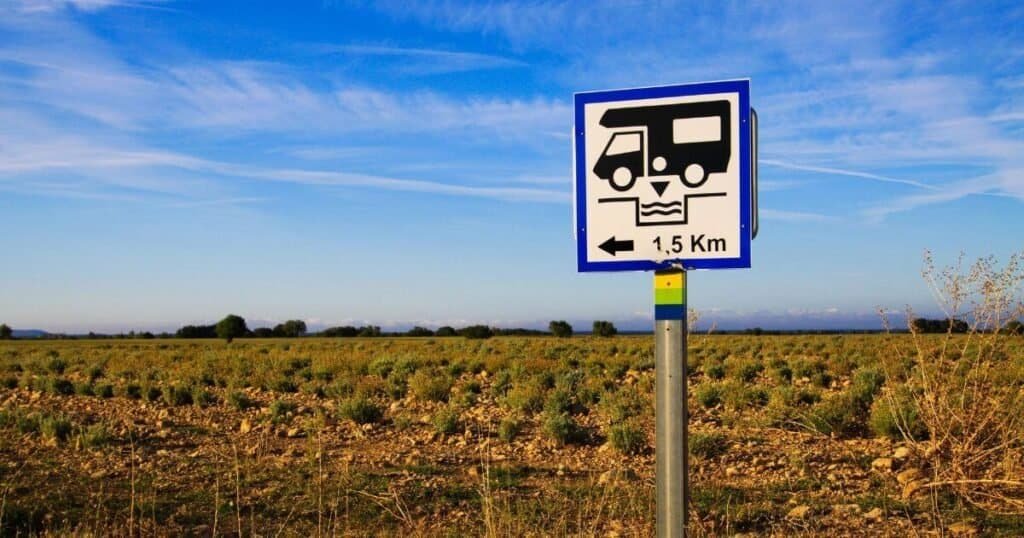
🔐 Comfort Needs and Privacy
If privacy is a priority, a well-designed enclosure or a separate bathroom area in your van can enhance your comfort.
For those more accustomed to the outdoor lifestyle, a simple portable or pop-up toilet might suffice, especially when paired with a privacy tent.
Where to Put a Toilet in Your Van: Campervan Toilet Layouts
Deciding where to place a toilet in your van is a crucial step in the design process, influencing both the functionality and comfort of your mobile home.
Whether you’re seeking a luxurious setup or a space-saving solution, there are multiple designs to consider, each with unique advantages and potential drawbacks.
🚿 Dedicated Bathroom Cubicle
A dedicated bathroom cubicle is the epitome of van luxury, offering a private, enclosed space for your toilet as well as a shower or sink. This setup is ideal for those prioritising comfort and privacy, making it feel like a home away from home.
However, it does require a significant amount of space, which might not be suitable for smaller vans or minimalist designs.
If you choose this option, ensure you have enough room to move comfortably and consider installing a fan or a window for ventilation. This setup is best for larger vans where space is less of a concern.
There are three main locations these cubicles are generally positioned in different van builds.
1. Behind the Drivers Seat
Shower cubicles here are aesthetically pleasing and make great use of the space opposite the sliding door. We love the semi-circular designs, which offer more room than rectangular cubicles in the van’s centre.
However, this layout can hinder access to the cab from inside the van, which is useful for transitioning from muddy or snowy conditions. It also makes the bathroom the first visible feature upon opening the door and takes up living space if you opt for a bigger cubicle.
Our camper van layout prioritises cab access and includes two captain chairs with an extendable countertop for added living and working space. So the ‘behind the drivers seat’ option didn’t work for us.

2. In The Centre of the Van
Placing a bathroom cubicle in the centre of a van, typically to one side of the aisle at the foot of a rear bed, offers various benefits.
This location avoids windows which enhances your privacy. It also allows you to utilise the floor-to-ceiling design and add a tall food larder on one side of the cubicle and a thin stacked wardrobe on the other side. It also creates a cosy bedroom space without blocking views from the back door.
While this setup offers privacy and can be an effective use of space, it can also make the van’s interior feel more cramped.

3. At The Back
Positioning the cubicle at the back of the van offers flexibility in size and design, potentially utilising the full width as a bathroom or mudroom.
However, there are drawbacks such as a potentially cramped feel, obstructed views from the back window, reduced storage options, encroachment on living space, and increased weight if you opt for a larger bathroom.
🥷 Hidden Away
In the world of campervans, space is at a premium and every square inch counts. When a designated bathroom cubicle isn’t possible, creative solutions for storing a portable toilet become essential. Here are some ideas on areas where you could tuck away your camper van toilet, ensuring it’s accessible, discreet and maximises your living space.
☑️ Bench Seat Storage
One of the most popular options is to hide the toilet within a bench seat. By designing a hinged or removable seat top you can easily access the toilet when needed, while it remains out of sight during the day. This solution is perfect for communal areas, allowing you to maintain an inviting space for relaxing or dining without compromising on functionality.
☑️ Under-Bed Compartments
For those with a platform bed setup, an under-bed compartment can serve as an excellent hiding spot for a portable toilet. This not only maximises space but keeps the toilet out of the way until required. By sliding the toilet out on a track or using a lift-up bed base, you can access it with minimal effort.
☑️ Cabinet Concealment
Integrating the toilet into a cabinet is another clever tactic. This might involve placing the toilet inside a kitchen or bathroom cabinet, with a simple door or sliding mechanism to reveal it when necessary.
☑️Convertible Furniture
Consider multifunctional furniture, such as a coffee table or ottoman, that can transform into a toilet station. With a flip-top lid or removable panel, these pieces can offer an unexpected yet practical solution for keeping your toilet under wraps.
☑️ Drawer Solutions
Custom-built drawers can provide a seamless way to incorporate a toilet into your campervan layout. With a pull-out drawer design, the toilet can be easily accessed and then stowed away without taking up valuable floor space. This method works particularly well in narrow corridors or tight spaces.
One downside of the hidden away toilet is the potential for smells. Make sure to try out various portable toilets to find the one that you think smells the least, and regardless of the layout design you choose, always maintain good ventilation inside your van.
The Wrap-Up: What is the Best Vanlife Toilet Option for your Campervan?
Selecting the best campervan toilet for you boils down to balancing personal preferences, space considerations, budget and practicality.
We prefer the pop-up camping toilet for emergencies because: we travel to extreme winter climates in our van, it saves space; simplifies cleanup with each of us managing our own waste, and eliminates the need for cleaning toilet basins or finding places to empty black water tanks.
It also prevents any unpleasant smells in the van, as no #2 is kept on board. So far we haven’t had any trouble finding public toilets on the road.
But what you are comfortable with will be down to you. Whether you opt for the simplicity of a portable toilet, the convenience of a composting option, the traditional feel of a fixed plumbed-in toilet, or no toilet at all, ensuring your choice meets your travel needs, van setup and lifestyle, is key.
We hope we have helped you feel more capable of making the best decision for your circumstances. With the right choice, you can enhance your vanlife experience, making your adventures on the road as comfortable and hassle-free as possible.
Interested in all things vanlife? Check out some of our other articles below 👍


